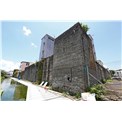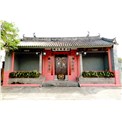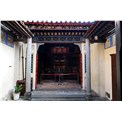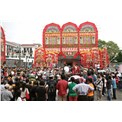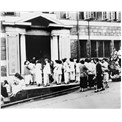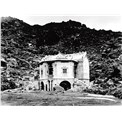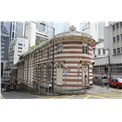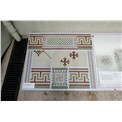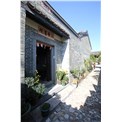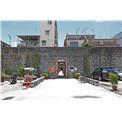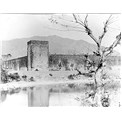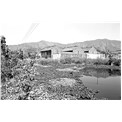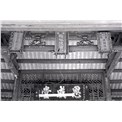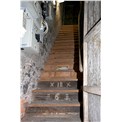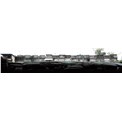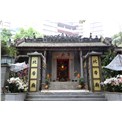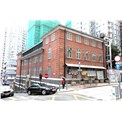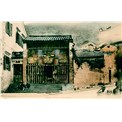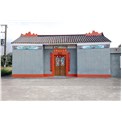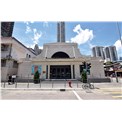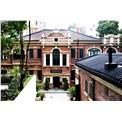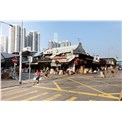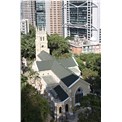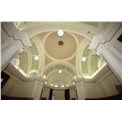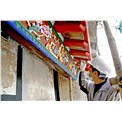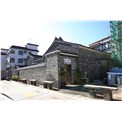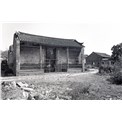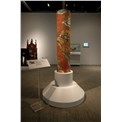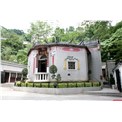Yuk Hui Temple
Yuk Hui Temple was built in 1863 to worship Pak Tai (God of the North), to allow both land residents and fishermen to seek the god’s protection and blessings. The temple has a two-hall layout. The roof ridge of the temple is decorated with delicate Shiwan ceramics. The stone plaque at the main entrance has the Chinese words "Yuk Hui Kung", written by Cheung Yuk Tong, a high-ranking military official in the Qing dynasty. A statue of Pak Tai, cast in the thirty-second year of the Wangli reign (1604) and now a valuable antique, is kept inside the temple.
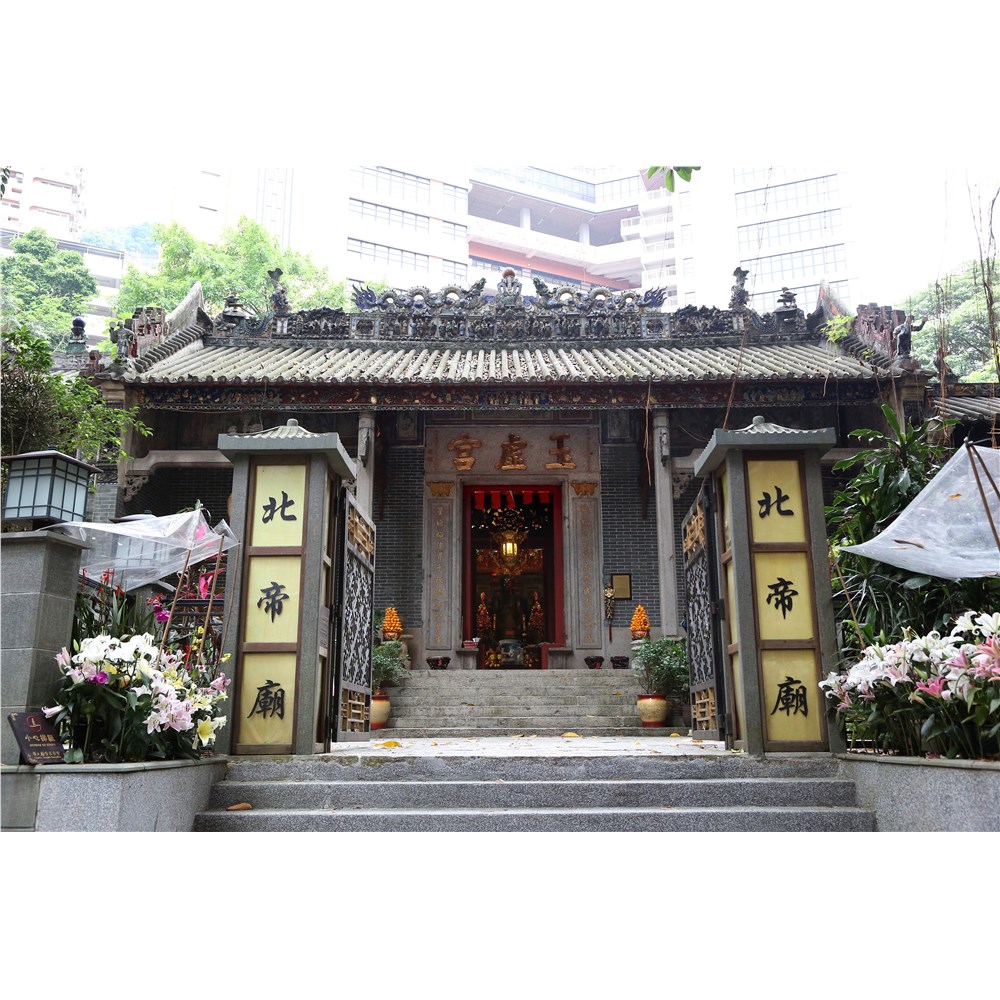
| Date | 2013 to 2016 |
| Place | Hong Kong Island/Wan Chai District/Wan Chai/Lung On Street/Yuk Hui Temple |
| object | Temple | Shiwan ceramic figurine |
| Material Type | Image |
| Collection | Reminiscences: Life in Hong Kong's Built Heritage |
| Source | Antiquities and Monuments Office |
| Repository | Antiquities and Monuments Office |
| Note to Copyright | Permission for use in Hong Kong Memory is given by Antiquities and Monuments Office |
| Accession No. | lcs-hkbh-0016 |
Yuk Hui Temple
Yuk Hui Temple was built in 1863 to worship Pak Tai (God of the North), to allow both land residents and fishermen to seek the god’s protection and blessings. The temple has a two-hall layout. The roof ridge of the temple is decorated with delicate Shiwan ceramics. The stone plaque at the main entrance has the Chinese words "Yuk Hui Kung", written by Cheung Yuk Tong, a high-ranking military official in the Qing dynasty. A statue of Pak Tai, cast in the thirty-second year of the Wangli reign (1604) and now a valuable antique, is kept inside the temple.
| Date | 2013 to 2016 |
| Place | Hong Kong Island/Wan Chai District/Wan Chai/Lung On Street/Yuk Hui Temple |
| Object | Temple | Shiwan ceramic figurine |
| Material Type | Image |
| Collection | Reminiscences: Life in Hong Kong's Built Heritage |
| Source | Antiquities and Monuments Office |
| Repository | Antiquities and Monuments Office |
| Note to Copyright | Permission for use in Hong Kong Memory is given by Antiquities and Monuments Office |
| Accession No. | lcs-hkbh-0016 |
Yuk Hui Temple
Yuk Hui Temple was built in 1863 to worship Pak Tai (God of the North), to allow both land residents and fishermen to seek the god’s protection and blessings. The temple has a two-hall layout. The roof ridge of the temple is decorated with delicate Shiwan ceramics. The stone plaque at the main entrance has the Chinese words "Yuk Hui Kung", written by Cheung Yuk Tong, a high-ranking military official in the Qing dynasty. A statue of Pak Tai, cast in the thirty-second year of the Wangli reign (1604) and now a valuable antique, is kept inside the temple.
| Date | 2013 to 2016 |
| Place | Hong Kong Island/Wan Chai District/Wan Chai/Lung On Street/Yuk Hui Temple |
| Object | Temple | Shiwan ceramic figurine |
| Material Type | Image |
| Collection | Reminiscences: Life in Hong Kong's Built Heritage |
| Source | Antiquities and Monuments Office |
| Repository | Antiquities and Monuments Office |
| Note to Copyright | Permission for use in Hong Kong Memory is given by Antiquities and Monuments Office |
| Accession No. | lcs-hkbh-0016 |
Yuk Hui Temple
Yuk Hui Temple was built in 1863 to worship Pak Tai (God of the North), to allow both land residents and fishermen to seek the god’s protection and blessings. The temple has a two-hall layout. The roof ridge of the temple is decorated with delicate Shiwan ceramics. The stone plaque at the main entrance has the Chinese words "Yuk Hui Kung", written by Cheung Yuk Tong, a high-ranking military official in the Qing dynasty. A statue of Pak Tai, cast in the thirty-second year of the Wangli reign (1604) and now a valuable antique, is kept inside the temple.
| Date | 2013 to 2016 |
| Place | Hong Kong Island/Wan Chai District/Wan Chai/Lung On Street/Yuk Hui Temple |
| Object | Temple | Shiwan ceramic figurine |
| Material Type | Image |
| Collection | Reminiscences: Life in Hong Kong's Built Heritage |
| Source | Antiquities and Monuments Office |
| Repository | Antiquities and Monuments Office |
| Note to Copyright | Permission for use in Hong Kong Memory is given by Antiquities and Monuments Office |
| Accession No. | lcs-hkbh-0016 |
Yuk Hui Temple
Yuk Hui Temple was built in 1863 to worship Pak Tai (God of the North), to allow both land residents and fishermen to seek the god’s protection and blessings. The temple has a two-hall layout. The roof ridge of the temple is decorated with delicate Shiwan ceramics. The stone plaque at the main entrance has the Chinese words "Yuk Hui Kung", written by Cheung Yuk Tong, a high-ranking military official in the Qing dynasty. A statue of Pak Tai, cast in the thirty-second year of the Wangli reign (1604) and now a valuable antique, is kept inside the temple.
| Date | 2013 to 2016 |
| Object | Temple | Shiwan ceramic figurine |
| Material Type | Image |
| Collection | Reminiscences: Life in Hong Kong's Built Heritage |
| Source | Antiquities and Monuments Office |
| Repository | Antiquities and Monuments Office |
| Note to Copyright | Permission for use in Hong Kong Memory is given by Antiquities and Monuments Office |
| Accession No. | lcs-hkbh-0016 |
Yuk Hui Temple
Yuk Hui Temple was built in 1863 to worship Pak Tai (God of the North), to allow both land residents and fishermen to seek the god’s protection and blessings. The temple has a two-hall layout. The roof ridge of the temple is decorated with delicate Shiwan ceramics. The stone plaque at the main entrance has the Chinese words "Yuk Hui Kung", written by Cheung Yuk Tong, a high-ranking military official in the Qing dynasty. A statue of Pak Tai, cast in the thirty-second year of the Wangli reign (1604) and now a valuable antique, is kept inside the temple.
| Date | 2013 to 2016 |
| Place | Hong Kong Island/Wan Chai District/Wan Chai/Lung On Street/Yuk Hui Temple |
| Object | Temple | Shiwan ceramic figurine |
| Material Type | Image |
| Collection | Reminiscences: Life in Hong Kong's Built Heritage |
| Source | Antiquities and Monuments Office |
| Repository | Antiquities and Monuments Office |
| Note to Copyright | Permission for use in Hong Kong Memory is given by Antiquities and Monuments Office |
| Accession No. | lcs-hkbh-0016 |
Yuk Hui Temple
Yuk Hui Temple was built in 1863 to worship Pak Tai (God of the North), to allow both land residents and fishermen to seek the god’s protection and blessings. The temple has a two-hall layout. The roof ridge of the temple is decorated with delicate Shiwan ceramics. The stone plaque at the main entrance has the Chinese words "Yuk Hui Kung", written by Cheung Yuk Tong, a high-ranking military official in the Qing dynasty. A statue of Pak Tai, cast in the thirty-second year of the Wangli reign (1604) and now a valuable antique, is kept inside the temple.
| Date | 2013 to 2016 |
| Place | Hong Kong Island/Wan Chai District/Wan Chai/Lung On Street/Yuk Hui Temple |
| Object | Temple | Shiwan ceramic figurine |
| Material Type | Image |
| Collection | Reminiscences: Life in Hong Kong's Built Heritage |
| Source | Antiquities and Monuments Office |
| Repository | Antiquities and Monuments Office |
| Note to Copyright | Permission for use in Hong Kong Memory is given by Antiquities and Monuments Office |
| Accession No. | lcs-hkbh-0016 |
Yuk Hui Temple
Yuk Hui Temple was built in 1863 to worship Pak Tai (God of the North), to allow both land residents and fishermen to seek the god’s protection and blessings. The temple has a two-hall layout. The roof ridge of the temple is decorated with delicate Shiwan ceramics. The stone plaque at the main entrance has the Chinese words "Yuk Hui Kung", written by Cheung Yuk Tong, a high-ranking military official in the Qing dynasty. A statue of Pak Tai, cast in the thirty-second year of the Wangli reign (1604) and now a valuable antique, is kept inside the temple.
| Date of Death | 2013 to 2016 |
| Place | Hong Kong Island/Wan Chai District/Wan Chai/Lung On Street/Yuk Hui Temple |
| Object | Temple | Shiwan ceramic figurine |
| Material Type | Image |
| Collection | Reminiscences: Life in Hong Kong's Built Heritage |
| Source | Antiquities and Monuments Office |
| Repository | Antiquities and Monuments Office |
| Note to Copyright | Permission for use in Hong Kong Memory is given by Antiquities and Monuments Office |
| Accession No. | lcs-hkbh-0016 |
Yuk Hui Temple
Yuk Hui Temple was built in 1863 to worship Pak Tai (God of the North), to allow both land residents and fishermen to seek the god’s protection and blessings. The temple has a two-hall layout. The roof ridge of the temple is decorated with delicate Shiwan ceramics. The stone plaque at the main entrance has the Chinese words "Yuk Hui Kung", written by Cheung Yuk Tong, a high-ranking military official in the Qing dynasty. A statue of Pak Tai, cast in the thirty-second year of the Wangli reign (1604) and now a valuable antique, is kept inside the temple.
| Date | 2013 to 2016 |
| Material Type | Image |
| Collection | Reminiscences: Life in Hong Kong's Built Heritage |
| Source | Antiquities and Monuments Office |
| Note to Copyright | Permission for use in Hong Kong Memory is given by Antiquities and Monuments Office |
| Accession No. | lcs-hkbh-0016 |
Yuk Hui Temple
Yuk Hui Temple was built in 1863 to worship Pak Tai (God of the North), to allow both land residents and fishermen to seek the god’s protection and blessings. The temple has a two-hall layout. The roof ridge of the temple is decorated with delicate Shiwan ceramics. The stone plaque at the main entrance has the Chinese words "Yuk Hui Kung", written by Cheung Yuk Tong, a high-ranking military official in the Qing dynasty. A statue of Pak Tai, cast in the thirty-second year of the Wangli reign (1604) and now a valuable antique, is kept inside the temple.
| Date | 2013 to 2016 |
| Media Type | Photo |
| Material Type | Image |
| Place | Hong Kong Island/Wan Chai District/Wan Chai/Lung On Street/Yuk Hui Temple |
| Object | Temple | Shiwan ceramic figurine |
| Collection | Reminiscences: Life in Hong Kong's Built Heritage |
| Source | Antiquities and Monuments Office |
| Repository | Antiquities and Monuments Office |
| Note to Copyright | Permission for use in Hong Kong Memory is given by Antiquities and Monuments Office |
| Accession No. | lcs-hkbh-0016 |
Yuk Hui Temple
Yuk Hui Temple was built in 1863 to worship Pak Tai (God of the North), to allow both land residents and fishermen to seek the god’s protection and blessings. The temple has a two-hall layout. The roof ridge of the temple is decorated with delicate Shiwan ceramics. The stone plaque at the main entrance has the Chinese words "Yuk Hui Kung", written by Cheung Yuk Tong, a high-ranking military official in the Qing dynasty. A statue of Pak Tai, cast in the thirty-second year of the Wangli reign (1604) and now a valuable antique, is kept inside the temple.
| Date | 2013 to 2016 |
| Place | Hong Kong Island/Wan Chai District/Wan Chai/Lung On Street/Yuk Hui Temple |
| Object | Temple | Shiwan ceramic figurine |
| Material Type | Image |
| Collection | Reminiscences: Life in Hong Kong's Built Heritage |
| Source | Antiquities and Monuments Office |
| Repository | Antiquities and Monuments Office |
| Note to Copyright | Permission for use in Hong Kong Memory is given by Antiquities and Monuments Office |
| Accession No. | lcs-hkbh-0016 |
Yuk Hui Temple
Yuk Hui Temple was built in 1863 to worship Pak Tai (God of the North), to allow both land residents and fishermen to seek the god’s protection and blessings. The temple has a two-hall layout. The roof ridge of the temple is decorated with delicate Shiwan ceramics. The stone plaque at the main entrance has the Chinese words "Yuk Hui Kung", written by Cheung Yuk Tong, a high-ranking military official in the Qing dynasty. A statue of Pak Tai, cast in the thirty-second year of the Wangli reign (1604) and now a valuable antique, is kept inside the temple.
| Date | 2013 to 2016 |
| Place | Hong Kong Island/Wan Chai District/Wan Chai/Lung On Street/Yuk Hui Temple |
| Object | Temple | Shiwan ceramic figurine |
| Material Type | Image |
| Collection | Reminiscences: Life in Hong Kong's Built Heritage |
| Source | Antiquities and Monuments Office |
| Repository | Antiquities and Monuments Office |
| Note to Copyright | Permission for use in Hong Kong Memory is given by Antiquities and Monuments Office |
| Accession No. | lcs-hkbh-0016 |
Yuk Hui Temple
Yuk Hui Temple was built in 1863 to worship Pak Tai (God of the North), to allow both land residents and fishermen to seek the god’s protection and blessings. The temple has a two-hall layout. The roof ridge of the temple is decorated with delicate Shiwan ceramics. The stone plaque at the main entrance has the Chinese words "Yuk Hui Kung", written by Cheung Yuk Tong, a high-ranking military official in the Qing dynasty. A statue of Pak Tai, cast in the thirty-second year of the Wangli reign (1604) and now a valuable antique, is kept inside the temple.
| Date | 2013 to 2016 |
| Place | Hong Kong Island/Wan Chai District/Wan Chai/Lung On Street/Yuk Hui Temple |
| Object | Temple | Shiwan ceramic figurine |
| Media Type | Photo |
| Material Type | Image |
| Collection | Reminiscences: Life in Hong Kong's Built Heritage |
| Source | Antiquities and Monuments Office |
| Repository | Antiquities and Monuments Office |
| Note to Copyright | Permission for use in Hong Kong Memory is given by Antiquities and Monuments Office |
| Accession No. | lcs-hkbh-0016 |
Yuk Hui Temple
Yuk Hui Temple was built in 1863 to worship Pak Tai (God of the North), to allow both land residents and fishermen to seek the god’s protection and blessings. The temple has a two-hall layout. The roof ridge of the temple is decorated with delicate Shiwan ceramics. The stone plaque at the main entrance has the Chinese words "Yuk Hui Kung", written by Cheung Yuk Tong, a high-ranking military official in the Qing dynasty. A statue of Pak Tai, cast in the thirty-second year of the Wangli reign (1604) and now a valuable antique, is kept inside the temple.
| Date | 2013 to 2016 |
| Place | Hong Kong Island/Wan Chai District/Wan Chai/Lung On Street/Yuk Hui Temple |
| Object | Temple | Shiwan ceramic figurine |
| Media Type | Photo |
| Material Type | Image |
| Collection | Reminiscences: Life in Hong Kong's Built Heritage |
| Source | Antiquities and Monuments Office |
| Repository | Antiquities and Monuments Office |
| Note to Copyright | Permission for use in Hong Kong Memory is given by Antiquities and Monuments Office |
| Accession No. | lcs-hkbh-0016 |
Yuk Hui Temple
Yuk Hui Temple was built in 1863 to worship Pak Tai (God of the North), to allow both land residents and fishermen to seek the god’s protection and blessings. The temple has a two-hall layout. The roof ridge of the temple is decorated with delicate Shiwan ceramics. The stone plaque at the main entrance has the Chinese words "Yuk Hui Kung", written by Cheung Yuk Tong, a high-ranking military official in the Qing dynasty. A statue of Pak Tai, cast in the thirty-second year of the Wangli reign (1604) and now a valuable antique, is kept inside the temple.
| Date | 2013 to 2016 |
| Place | Hong Kong Island/Wan Chai District/Wan Chai/Lung On Street/Yuk Hui Temple |
| Object | Temple | Shiwan ceramic figurine |
| Media Type | Photo |
| Material Type | Image |
| Collection | Reminiscences: Life in Hong Kong's Built Heritage |
| Source | Antiquities and Monuments Office |
| Repository | Antiquities and Monuments Office |
| Note to Copyright | Permission for use in Hong Kong Memory is given by Antiquities and Monuments Office |
| Accession No. | lcs-hkbh-0016 |
Yuk Hui Temple
Yuk Hui Temple was built in 1863 to worship Pak Tai (God of the North), to allow both land residents and fishermen to seek the god’s protection and blessings. The temple has a two-hall layout. The roof ridge of the temple is decorated with delicate Shiwan ceramics. The stone plaque at the main entrance has the Chinese words "Yuk Hui Kung", written by Cheung Yuk Tong, a high-ranking military official in the Qing dynasty. A statue of Pak Tai, cast in the thirty-second year of the Wangli reign (1604) and now a valuable antique, is kept inside the temple.
| Date | 2013 to 2016 |
| Place | Hong Kong Island/Wan Chai District/Wan Chai/Lung On Street/Yuk Hui Temple |
| Object | Temple | Shiwan ceramic figurine |
| Media Type | Photo |
| Material Type | Image |
| Collection | Reminiscences: Life in Hong Kong's Built Heritage |
| Source | Antiquities and Monuments Office |
| Repository | Antiquities and Monuments Office |
| Note to Copyright | Permission for use in Hong Kong Memory is given by Antiquities and Monuments Office |
| Accession No. | lcs-hkbh-0016 |
Yuk Hui Temple
Yuk Hui Temple was built in 1863 to worship Pak Tai (God of the North), to allow both land residents and fishermen to seek the god’s protection and blessings. The temple has a two-hall layout. The roof ridge of the temple is decorated with delicate Shiwan ceramics. The stone plaque at the main entrance has the Chinese words "Yuk Hui Kung", written by Cheung Yuk Tong, a high-ranking military official in the Qing dynasty. A statue of Pak Tai, cast in the thirty-second year of the Wangli reign (1604) and now a valuable antique, is kept inside the temple.
| Date | 2013 to 2016 |
| Place | Hong Kong Island/Wan Chai District/Wan Chai/Lung On Street/Yuk Hui Temple |
| Object | Temple | Shiwan ceramic figurine |
| Material Type | Image |
| Collection | Reminiscences: Life in Hong Kong's Built Heritage |
| Source | Antiquities and Monuments Office |
| Repository | Antiquities and Monuments Office |
| Note to Copyright | Permission for use in Hong Kong Memory is given by Antiquities and Monuments Office |
| Accession No. | lcs-hkbh-0016 |
Yuk Hui Temple
Yuk Hui Temple was built in 1863 to worship Pak Tai (God of the North), to allow both land residents and fishermen to seek the god’s protection and blessings. The temple has a two-hall layout. The roof ridge of the temple is decorated with delicate Shiwan ceramics. The stone plaque at the main entrance has the Chinese words "Yuk Hui Kung", written by Cheung Yuk Tong, a high-ranking military official in the Qing dynasty. A statue of Pak Tai, cast in the thirty-second year of the Wangli reign (1604) and now a valuable antique, is kept inside the temple.
| Date | 2013 to 2016 |
| Place | Hong Kong Island/Wan Chai District/Wan Chai/Lung On Street/Yuk Hui Temple |
| Object | Temple | Shiwan ceramic figurine |
| Material Type | Image |
| Collection | Reminiscences: Life in Hong Kong's Built Heritage |
| Source | Antiquities and Monuments Office |
| Repository | Antiquities and Monuments Office |
| Note to Copyright | Permission for use in Hong Kong Memory is given by Antiquities and Monuments Office |
| Accession No. | lcs-hkbh-0016 |
Copyright © 2012 Hong Kong Memory



